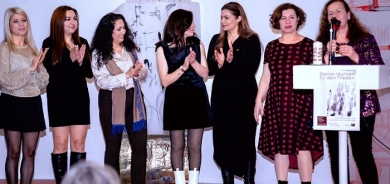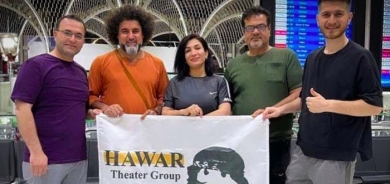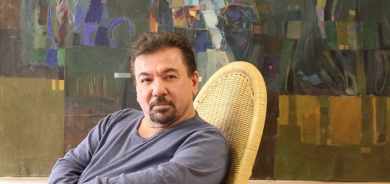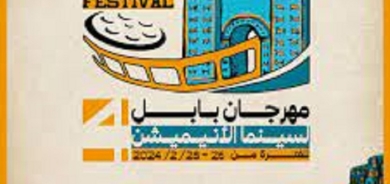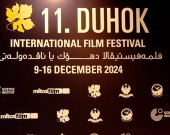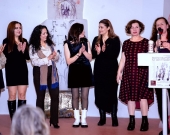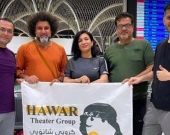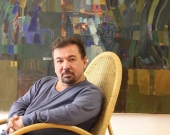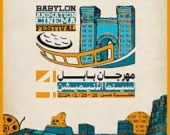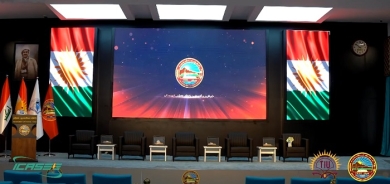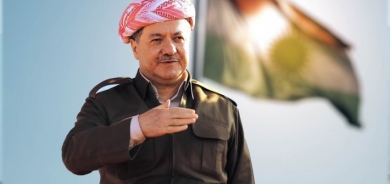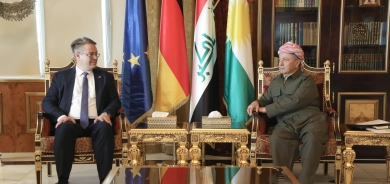‘I paint for my dreams’: art in the Yezidi camp of Bajed Kandala

A small huddle of containers overlooking mountains are perched close to the Syrian border. They house Joint Help for Kurdistan (JHK), one of eight NGOs operating in the camp. Established by Kurdish-Swedish doctors after the genocide of Yezidis by the Islamic State began in 2014, the organisation provides not just the medical aid the camp’s residents so desperately need, but holistic and educational activities too.
Little distinguishes the exterior of these containers. One, however, hosts a group of Yezidi men and boys huddled over easels and tins of paint.
The space, also home to English and coding classes, is a welcome reprieve from camp life for Bajed Kandala’s men, women and children.
Launched by JHK since early 2016, the classes were originally a short-term project. They became a more permanent camp fixture upon the request of camp residents, JHK co-founder Nemam Ghafouri told Rudaw English.
Classes run from anything between three to six times a week, depending on the availability of the volunteers who keep them in session.
This week’s classes are facilitated by Mattina Hiwaizi, a fine art graduate from London. A veteran volunteer for JHK’s education program, Hiwaizi has visited the camp eight times. As she walks around the small space filled with art supplies, she fields eager questions from the budding artists.
Hiwaizi remarked on the therapeutic impact of the programme on the residents.
“People who’ve been coming for a while seem to find it much easier to communicate their emotions and talk about difficult things with us,” she told Rudaw English on Sunday.
Khairullah Suliman, 16, arrived at the camp five years ago from the long-suffering Yezidi village of Tel Ezer. Rocked by devastating al-Qaeda bombings in 2007, it was seized by ISIS seven years later.
“Life here was bad, our situation was bad [when we arrived]. It is still bad, but now it’s a bit better,” he said, adding strokes of white to his landscape canvas of a lakeside scene.
With a severe lack of psychosocial services available to IDPs, the men are open about how art has helped them mentally.
“I do it for my brain. Nothing else,” says Barzan Khaider, 27, from the village of Borek. “When you suffer from something you can show [art] to your friends, your community. Through my painting I can say I suffer from this, this is my meaning, these are my difficulties.”
Many artists within the community focus on the horrors the Yezidis have faced at the hands of ISIS. Khaider says that the aim of his art is to relax, and focus on hopes for a better future.
“I paint for my dreams. I paint for my hopes, things in my mind, to start a new life,” he added, staring at his painting of the mountains surrounding Rio de Janeiro, where he hopes to settle.
“Brazil is a good country, good people,” he added. “I want to be the first to go there.”
Asylum abroad is a hot topic of discussion as they search for paint and brushes in the small container. Some 100,000 of the once half a million-strong Yezidi community in Iraq have sought refuge overseas. A staggering 360,000 of the 400,000 who remain in Iraq are living in camps like Bajed Kandala, which is also home to Yezidis displaced by conflict and persecution in Syria.
Suliman has been here for five years. He hopes to go to Australia’s east coast, home to a burgeoning Yezidi community. His uncle left Syria as a refugee three decades ago and now lives in Sydney.
“When I paint, I become more comfortable, my dreams become stronger,” he said, adding finishing touches to his piece.
With residents are free to use the art supplies in their own time, Suliman paints regularly in his tent. He is a prolific artist, flipping eagerly through his phone to show us his other work.
He says that there were many artists in Shingal, but a lack of supplies meant many did not pursue art until it was offered by NGOs in the camps.
“This took me one hour,” he said, pointing to a colour painting of a dancer.
Painting is his main hobby, but takes a backseat to his ardent school studies.
“If I have homework, I cannot paint. I am the second-best student in my class, and I can’t let my grades drop,” he says, before turning his attention to his upcoming asylum interview.
As we leave, a young man beams for the camera with his finished piece.
Many of his friends, we are told, died in the attack on Shingal. Through art, he was now found new friends, and a safe haven where the past can be forgotten.
Rudaw


